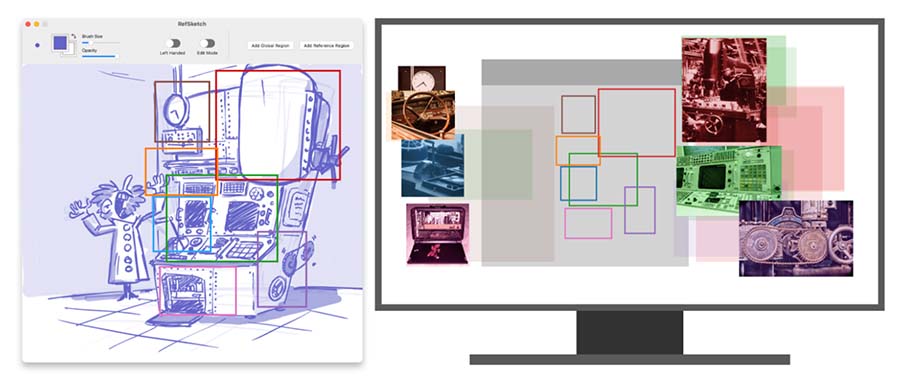Supporting Reference Imagery
for Digital Drawing

I'm excited to finally share Supporting Reference Imagery for Digital Drawing1, the research project I worked on over the course of my MSc degree at the University of Toronto under the co-supervision of Professors Alec Jacobson and Fanny Chevalier. Click that link above to go to project page where you can find the paper itself, a nice video summary, access to the interface we designed, as well as other supplemental material.
As an illustrator using predominantly digital tools to create artworks over the years, I've always been curious about how the tools we use can better support artists. From my experience, the use of reference imagery in various image editing software has always felt a little clunky and I was curious what the state of research was in this domain. Thus began my research journey. In a nutshell, this research occured in two parts, which I'll provide an overview of below.
PART ONE Recognizing a gap in literature in this (admittedly niche) space, we first conducted interviews with a variety of artists to better understand how and why they use reference imagery as part of their creative process and the challenges they face. Most artists adopt unique approaches when integrating reference imagery into their workflows. Many view reference in a side-by-side manner, such as viewing reference in a web browser or image viewer beside their image editing software. This comes with one obvious challenge: the amount of real estate on the artists screen becomes limited because of multiple application windows being used at once.
Some artists described importing their reference directly into their working art file (be it Photoshop, or Illustrator, or whatever). This comes with its own set of gotchas, such as reference occluding their artwork or managing reference within a giant layer stack. Regardless, visual clutter was a common challenge artists faced. The use of reference can also come with some cognitive overhead such as constantly toggling reference visibility on and off, which in turn can interupt the creative workflow. There is also the potential to over fixate on reference, leading to the inadvertent over-copying their reference imagery. Check out the concept of design fixation2 if this interests you.
PART TWO After forming a better understanding of digital reference landscape, we designed a minimal sketch based interface intended for tablet users to collect data on how artists use reference. You can download the interface and try it for yourself if you're a macOS user. This digital sketchpad also came with a feature we call reference regions. Basically, these are rectangular regions the artist can create on their digital canvas to associate with reference images. When their stylus enters one of these regions, reference imagery is automatically made visible. When their stylus leaves, the reference is hidden away.
Using this interface, we conducted an open ended study with artists to see how such a feature gets adopted and found that artists adopted them in a variety of approaches, and many of them similar. Most artists would set up their reference regions in the same portion of the canvas that they were drawing their subject in, so that reference would appear when they were drawing. Others would set their regions alongside the edges of the canvas away from the subject, forcing them to internalize their reference before drawing.
In our study exit interviews, artists responded very positively to using our interface, and imagined how useful this could be in their professional workflows. We see this as a victory in identifying an opportunity to better support artists in tomorrow's tools, and wonder how just-in-time presentation of reference can be further explored in other contexts, such as 3D modelling or text editing.
Check out the project page to read the full paper and to see the drawings that artist produced using our interface.
Thanks for reading!
1 This work was presented at the Sketching for Human Expressivity Workshop, as part of ICCV '21, where it won the Best Paper Award.
2 David G. Jansson, Steven M. Smith. Design fixation. Design Studies, 1991.